
Caja, New Mexico, 1760–1800. Pine. H. 30", W. 55", D. 19". (Courtesy, Sotheby’s.)
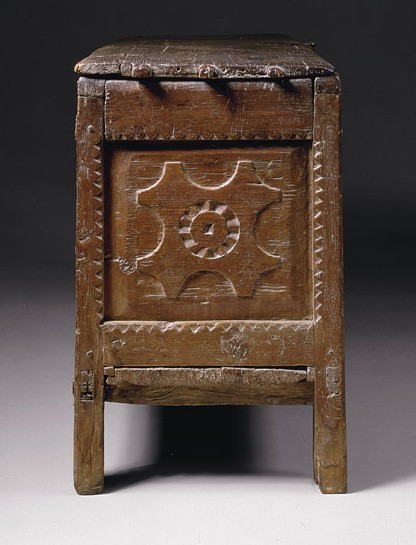
Detail of the side of the caja illustrated in fig. 1.
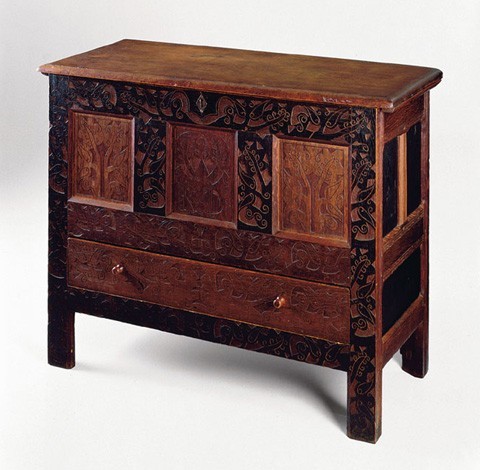
Chest, Hadley-Hatfield area of Massachusetts, ca. 1710. Oak with pine. H. 45", W. 36", D. 19 3/4". (Courtesy, Chipstone Foundation; photo, Gavin Ashworth.)
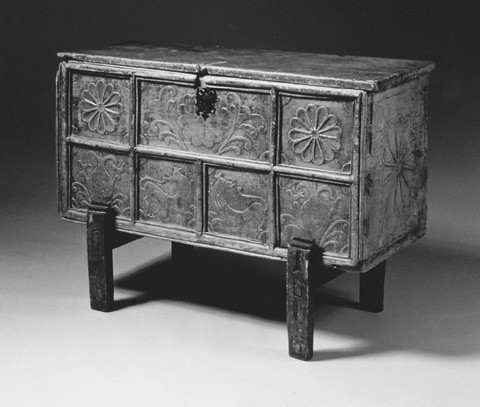
Caja, New Mexico, 1760–1800. Pine. H. 23", W. 47", D. 21". (Courtesy, Colorado Springs Fine Arts Center, Taylor Museum.)

Caja, New Mexico, 1760–1800. Pine. H. 22 1/2", W. 34 1/2", D. 17 1/4". (Courtesy, Sotheby’s.)

Caja, New Mexico, 1760–1800. Pine. H. 32 1/2", W. 37 1/2", D. 17". (Courtesy, Sotheby’s.)

Saint Anthony of Padua and the Infant Jesus, Santo Domingo Pueblo, New Mexico, 1693–1710. Painted hide. 46 1/2" x 26 3/8". (Courtesy, Division of Cultural History, National Museum of American History, Smithsonian Institution.)
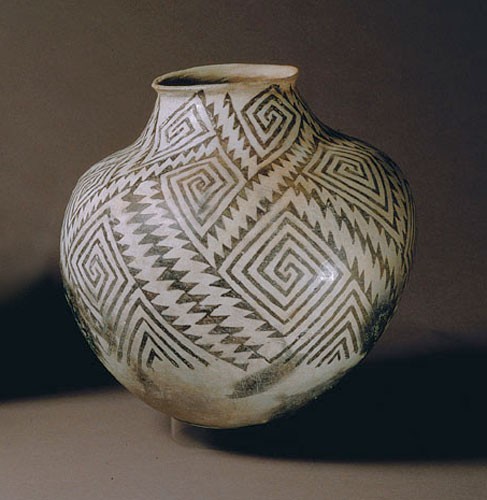
Tusayan storage jar, New Mexico, 1100–1300 A.D. Earthenware with black-on-white decoration. H. 14". (Courtesy,
Sotheby’s.)

Taos Pueblo, Taos, New Mexico. (Courtesy, Museum of New Mexico.) This image shows the Taos Pueblo as it appeared about 1880.
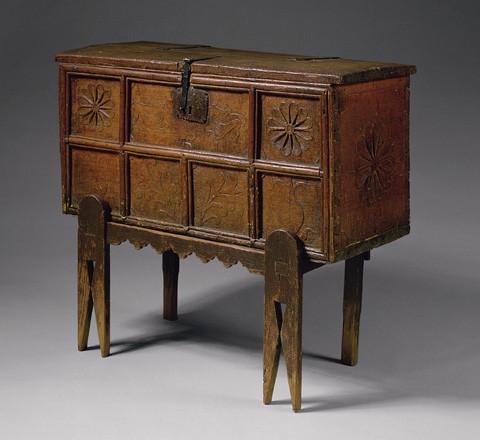
Caja, New Mexico, 1760–1800. Pine. H. 22", W. 44", D. 201/2". (Courtesy, Sotheby’s.)
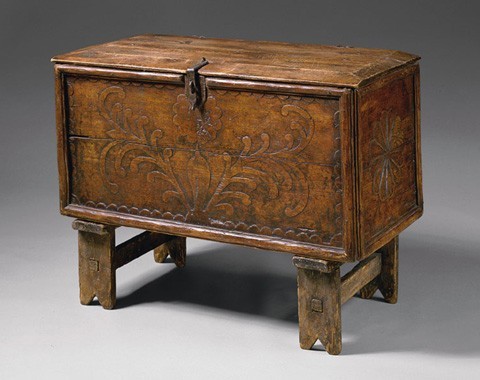
Caja, New Mexico, 1760–1800. Pine. H. 18 1/2", W. 37", D. 19". (Courtesy, Sotheby’s.)

Detail of an interior wall of La Hacienda de los Martinez, Taos, New Mexico, ca. 1805. (Photo, Anthony Richardson.)
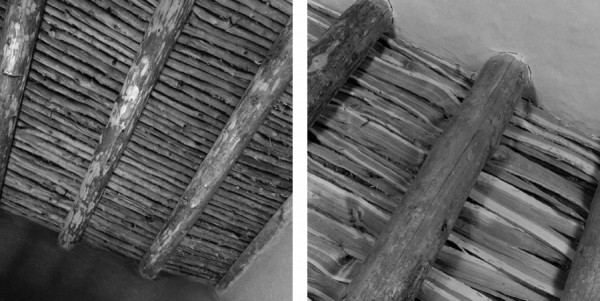
Detail of the ceilings of La Hacienda de los Martinez, Taos, New Mexico, ca. 1805, showing (left) aspen or cottonwood latillas (poles) and (right) split cedar or pine rajas (boards). (Photo, Anthony Richardson.)
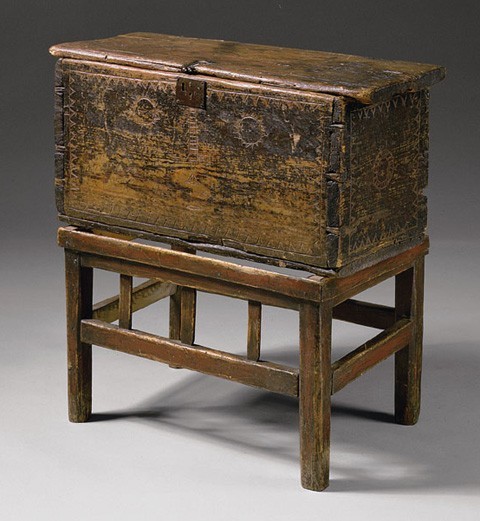
Caja, New Mexico, 1750–1800. Pine. H. 15 1/2", W. 33", D. 13 1/2". (Courtesy, Sotheby’s).
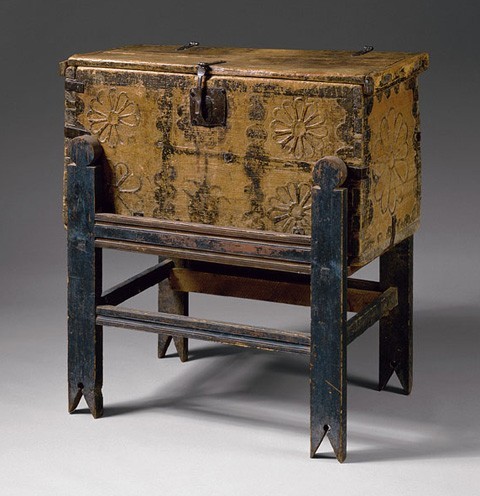
Caja, New Mexico, 1760–1800. Pine. H. 20 1/2", W. 38 1/2", D. 19". (Courtesy, Sotheby’s).

Refectory table, Spain, 1600–1700. Oak. Dimensions not recorded. (Courtesy, Isabella Stewart Gardner Museum, Boston.)
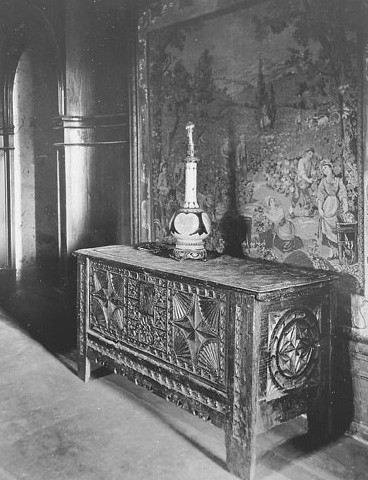
Chest, Spain, 1600–1700. Oak. Dimensions not recorded. (Courtesy, Hispanic Society of America, New York.)
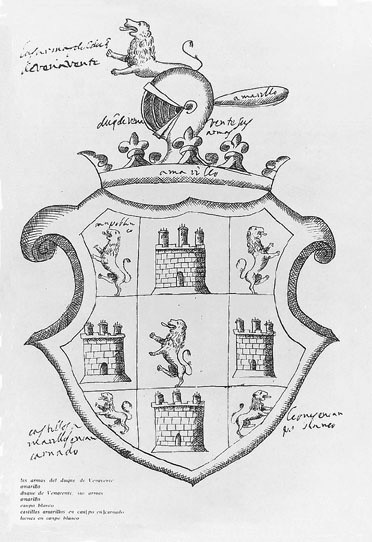
Design for a coat-of-arms, Spain, Origen y Armas de varios nobles de Espána. (Courtesy, Biblioteca de la Universidad de Zaragoza, ms. no. 198.)

Zuni bowl, New Mexico, ca. 1890. Earthenware with polychrome decoration. H. 6 1/2", Diam. 16 1/2". (Courtesy, Margorie and Charles Benton, Evanston, Illinois.)

Kiva interior, Meshongnovi Hopi village, Arizona, c. 1902. (Courtesy, Field Museum.)
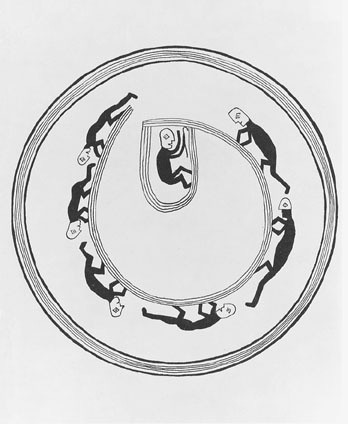
Design from Mimbres bowl, New Mexico, 900–1200 A.D. Earthenware with black-on-white decoration. Dimensions not recorded. (Courtesy, Patricia Carr, Mimbres Mythology, 1979.)
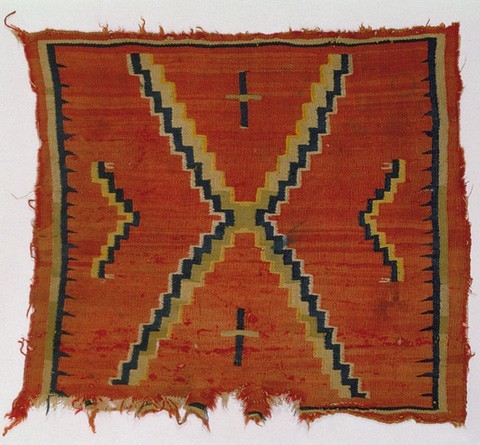
Navajo saddle blanket, New Mexico, 1880–1900. 32" x 28". (Courtesy, Museum of Indian Arts and Culture/Laboratory of Anthropology, Museum of New Mexico.)
In traditional Native American lore, the coyote plays the role of ubiquitous trickster. As an agent of disorder, this animal symbolizes the belief that imperfection gives the world its dynamism and liveliness. With Hispanic settlement in New Mexico from the seventeenth century on, the word “coyote” expands in use to identify mixed-race individuals, themselves signifiers of change and diversification. The author’s guise in this article will be that of the coyote who challenges entrenched notions about Spanish colonial furniture within the broader field of American decorative arts.[1]
Just as there is an Anglo bias to early American historiography, which emphasizes looking to New England for a sense of the past, there is a New England bias to American decorative arts scholarship. One result is that scholars and collectors have developed subjective ranking systems that often ignore the complexities and nuances of other regional styles, technologies, and tastes. The Spanish and Native American influences manifest in the style and structure of New Mexican cajas (figs. 1, 2) are the products of an environment that differed radically from that of colonial New England. This disparity is apparent in the decoration and construction of furniture (fig. 3).[2]
Two distinct types of cajas serve as the focal point for this article. The first type consists of dovetailed board chests with low-relief carving depicting heraldic devices such as lions, pomegranates, vines, and rosettes (figs. 4, 5). Some historians have suggested that these chests originated in the southern Río Abajo area of New Mexico, but their evidence is inconclusive. The second type of caja, which features mortise-and-tenon joinery and geometric chip-carving (figs. 1, 6), is associated with the Taos–Santa Cruz region of northern New Mexico.[3]
Our perceptions regarding early New Mexico have been dominated by the theme of conquest and exploitation. One of the most widely held beliefs is that the Hispanics, under the jurisdiction of the Spanish Crown and Catholic Church, arrived in New Mexico in 1598 and immediately and methodically began to dislocate and annihilate the Native American population. This oversimplified viewpoint erroneously assumes a separation of indigenous and European cultures analogous to that in New England. Another widely accepted notion maintains that a mentality of “making do” with available materials prevailed on the Spanish colonial frontier and resulted in a rather primitive material culture. This misconception results from equating the New Mexican experience with that of European colonists in the New England wilderness.
A more accurate interpretation of the seventeenth- and eighteenth-century Spanish occupation of New Mexico, particularly after the Pueblo Revolt of 1680 and Spanish reconquest in 1692, balances the military and religious forces imposed on the Pueblos with Hispanic dependency on Native Americans for survival. Rather than eradicating indigenous culture, Hispanic traditions intermingled with those of the Pueblos and were integrated on a variety of fronts, particularly marriage, trade, and craft traditions. Native Americans provided major population infusions into Spanish communities. In the first New Mexican settlement expedition of 1598, only 13 of 131 soldiers arrived with spouses. By 1776, the estimated Spanish population had grown to over ten thousand, as compared to eight thousand Pueblo Indians. This growth was made possible not by Hispanic women making the trek to the northern frontier over the two centuries, but by the integration of Native Americans into Hispanic communities through marriage, enslavement, and mercenary opportunities. The 1790 census of Albuquerque records that 69 percent of the marriages surveyed were between different racial groups.[4]
Just as distinct racial communities mixed freely, goods were regularly exchanged between the Spanish and Native American populations. Although dependent on Indian products such as corn, textiles, and furs for their livelihood and sustenance, Europeans often exploited Native American labor and values. The notion of “making do” is therefore also inappropriate to the northern frontier of New Spain. Upon entering the Rio Grande Valley, the Spanish encountered village-dwelling agriculturists and artisans who possessed firmly entrenched communal and cultural traditions, well-evolved languages, and permanent communities constructed of adobe and timber. Unlike many of the Indians first encountered in Mexico or on the East Coast, the Pueblos were gente vestida (clothed people): “[M]ost if not all the men wore cotton blankets and on top of these a buffalo hide. Some covered their privy parts with small cloths, very elegant and finely worked. The women wore . . . turkey-feather cloaks.”[5]
Frontier survival entailed harnessing the existent Pueblo culture. The building of Franciscan missions, for example, involved Pueblo labor and native technologies including transverse clerestory windows and façade orientation to the east or southeast, as opposed to the European tradition of west-facing façades. In addition, archaeological evidence shows that the Franciscans commissioned Pueblo potters to make ceramic vessels in European forms such as chalices and soup bowls. Eager to capitalize upon the Pueblo artisan economy they first encountered, the Franciscans also trained the Pueblo Indians in new trades including textile weaving and woodworking.[6]
From the outset, the Spanish colonial settlements began to develop a unique Hispanic-Pueblo material culture. The two traditions had differing, but equally complex, relationships to the land. Spanish culture was tempered both by the New Mexican environment and by physical distance from its epicenter—Madrid. In contrast, the New Mexican landscape was a spiritual and sacred center for the Pueblo Indians. It gave birth to their people and was at the core of their religious beliefs. Notwithstanding this disparity in orientation, both the Spanish and the Pueblo relationships to New Mexico were grounded in their respective histories. A characterization of the Spanish colonial frontier might thus center on its adherence to a broad spectrum of religious and cultural traditions—both of Old-World Spain and of ancient Pueblo and nomadic Native American tribes. This revered connection to and reliance upon tradition establishes New Mexico as a very different colonial frontier from New England, which was economically linked to the mother country but was settled by those who wanted to escape Old-World religious and cultural constraints.[7]
The traditional orientation of eighteenth-century New Mexico was manifested in the strength of religion, the coexistence of cultures, and the material nature of Spanish colonial objects. Both Christianity and Native American spiritualism were vibrant institutions on the frontier during the eighteenth century. Led by Don Diego de Vargas, the reconquest of New Mexico in 1692 was driven by the missionary impulse of the Catholic Church and the Spanish government’s need to thwart French and British expansion in the area. Vargas’s triumphal reentry into Santa Fe involved not only carrying a wooden statue of “Our Lady of the Conquest,” but also a ceremonial kissing of the cross by both Vargas and Pueblo leaders to indicate allegiance to the Catholic god and Spanish king. The religious zeal of the Franciscans, who relished the prospect of frontier martyrdom in the service of their god, led them to transport the cross, once again, throughout the territory—rebuilding Pueblo missions and churches and meticulously recording baptisms of Indians throughout the century. Despite the conversions to Christianity taking place, Native American religious beliefs persisted. The present-day survival of many rituals and religious stories testify to the preservation of Native American spiritualism during the eighteenth century. Kivas, which were the holy centers of Pueblo communities, were maintained within pueblos even though Franciscans sought to destroy them. Owing to the strength of Native American beliefs, Franciscans were forced to integrate these two faith systems. Images of the Christian god and Christian saints were modified to relate visually to Pueblo katsina (rain spirits) and dead ancestors, as well as to harness the power of nature-derived Pueblo symbols. Clouds, for example, became important components in New Mexican representations of saints, Jesus Christ, and God the Father (fig. 7).[8]
Ordinances drawn up in late-sixteenth-century Spain and Mexico served as the principal blueprints for New Mexican colonization through 1821. The Laws of the Indies, compiled in 1573 by King Philip II of Spain, provided instructions and mandates concerning city planning, governance systems, and interracial relations. Old-World regulations, such as the 1568 “Ordinances of the Trades of Carpenters, Joiners, and Musical Instrument Makers of the City of Mexico,” directed the administration and production quality of craft guilds throughout New Spain and formally encouraged the apprenticeship of Indians. Despite divergent circumstances and distance between New Mexico and Mexico, not to mention between New Mexico and Spain, these rules led to the persistence of Old-World governing practices and served as a blueprint for managing hospitable relations with native populations. On principle, the Pueblo people were amenable to cultural coexistence according to their communal codes of conduct. Ideals of synthesis, association, and harmony guided their interaction with each other as well as with the Spanish. From a practical point of view, such an Hispanic-Pueblo alliance offered increased protection from the attacks of nomadic Native Americans and other Europeans. In both Hispanic and Pueblo realms, dependence upon value-laden systems derived from their respective traditions was a way of rationalizing the irrational and of making the unfamiliar routine.[9]
Inherent in the reverence for history in the region was an interest in preservation which, at least in the case of the Hispanic New Mexicans, was played out on a material level. Like many European chests made from the Renaissance to the seventeenth century, cajas are constructed of thick boards, panels, and framing members. This durable structure conforms to art historian George Kubler’s notion of “strong surfaces.” According to Kubler, solidity signifies abundant raw materials and is an identifying trait of colonial artisanry.[10]
The physical qualities of early New Mexican furniture encourage a more thorough analysis of the two distinct types of cajas—heraldic board chests and chip-carved framed chests. These chests reveal much about their makers and about values concerning recyclability, safekeeping, and adornment prevalent on the New Mexican frontier by the end of the eighteenth century. Differences in the structure and decoration of cajas reflect two contrasting strategies for survival on the Spanish colonial frontier. The heraldic board chests lack legs, and are isolationist in design and mobile in form. They were literally the means by which Old-World Spain and its authority were transported into the northern frontier. Supply caravans traveled from as far south as Mexico City and brought a variety of textiles, ceramics, metalwork, and even such exotic Spanish foodstuffs as almonds and olive oil. The most precious goods were stored in cajas, both on journeys northward and in homes. Although the framed chests with abstract chip-carved patterns served a similar storage function, their formal elements reflect integration—the intermingling of sophisticated Old-World cabinetmaking techniques and Native American decoration. With stiles extending into legs, the Hispanic caja form is typically fixed in place.[11]
In light of these varied impressions, the cajas demand a modification of Kubler’s thesis regarding the interaction of central and peripheral cultures. He contends that cultures occupying a provincial edge remain insulated from other cultures that are geographically close but do not originate from the same center. While the board chests confirm his notion of the separatist tendencies of peripheral cultures, the framed chests with chip-carving suggest the opposite. They indicate that complex cultural products arise when a peripheral culture, like that of the Spanish in New Mexico, comes in direct contact with the center of another culture, in this instance that of the Pueblos.[12]
Late-eighteenth-century New Mexican cajas demonstrate the adeptness and flexibility of available woodworking technology as well as the social values and subsistence priorities of those who owned interior furnishings. Early woodworking in New Mexico engaged the skills and sensibilities of both Hispanic and Pueblo craftsmen. At least seven Spanish carpinteros arrived in New Mexico with Juan de Oñate’s settlement expedition in 1598. These Hispanic artisans and their successors built missions, towns, and haciendas; made household necessities such as chairs, cajas, trasteros (cupboards) and graineros (storage cabinets); and produced spiritual objects such as retablos and bultos (carved images of saints). The Pueblo people also practiced carpentry with considerable skill. Initially trained by Franciscans in order to satisfy the needs of local missions, the Pecos and Abó pueblos became major woodworking centers as early as the seventeenth century and produced household goods and architectural components. On a fact-finding tour of the New Mexican missions in 1776, Fray Francisco Dominguez described the Indians of the Pecos pueblo as good carpenters whose skills were in great demand across the colony, from Taos to Isleta, and who thus had a high degree of economic mobility. Other eighteenth-century reports about the Pecos pueblo mention lumber prepared by local carpenters and delivered to Santa Fe, as well as made-to-order doors, window frames, and beds.[13]
New Mexican woodworkers typically had a few basic tools: an ax for felling trees; a pit saw and a hand saw for cutting timber; an adze for smoothing boards; a plane for producing finished surfaces; chisels for cutting joints and carving; an auger for boring; and knives, a grooving plane, and a compass for creating surface decoration. The diversity of formal adaptations and innovations applied to construction and ornament denote the flexibility of this woodworking technology and the production systems that grew up around it. Dramatic developments in carpentry and joinery came with the intermingling of Native American and Hispanic traditions. Seemingly similar forms, for example, often have strikingly different aesthetic traits. The dovetailed board chests illustrated in figures 4 and 5 are Spanish in both construction and decoration. Similarly, the heraldic carving and attached moldings reveal that the craftsmen were familiar with the standardized imagery and structural practices maintained by Spanish and Mexican woodworking guilds. In contrast, the carving on framed chests (see figs. 1, 6) is reminiscent of the rhythmic linear patterns on ancient Anasazi and contemporary Pueblo pottery (fig. 8), and of architectural elements such as the stacking of adobe cube houses and the pervasive use of wooden ladders (fig. 9).[14]
Despite their differences, many of the framed and board cajas are similar in basic design and proportion. New Mexican woodworkers typically used squares based on fractions of the vara (eighty-four centimeters) to lay out their case designs and decorative grids. The chest illustrated in figure 5, for example, is one vara wide and one-half vara deep, whereas the caja shown in figure 10 is one-and-one-third vara wide, two-thirds vara high, and almost two-thirds vara deep. Small cajas are almost invariably twice as wide as they are deep, whereas larger ones tend to be three times as wide as they are deep. The corner posts on standard framed cajas (see fig. 1) are at least as high as the chest is deep; whereas those on chests with elaborate bases are typically one-and-one-half to two times as high as the chest is deep (see fig. 6). Similarly, decoration on cajas generally falls into one of three basic patterns. Either the surface has been divided like a grid into seven panels (see figs. 4, 5, 10), or it holds two comparable symmetrical designs (see figs. 1, 6), or it is a single composite scheme (fig. 11). On every chest included in this study the maker laid out most of the decoration with a compass.[15]
These entrenched proportional systems and the prevalence of cajas from the seventeenth century on indicate that woodworkers produced these forms with a conscious sense of the past. As material expressions of continuity and conformity, cajas reflect their makers’ training and owners’ cultural values, wealth, and tastes. This concept also relates to the solid structure and strong visual quality of cajas and to their physical state today. Both the board chests and their framed counterparts give substance to Kubler’s notion that “colonial surfaces . . . [have an] inner strength . . . [which] gladly accepts every kick and bruise without horrid damage.” The damaged and repaired surfaces of these chests attest to their continued service within a household or community and to the need to preserve forms and raw materials on the frontier. Replaced locks, hinges, boards, supports, and lids; broken or repaired corners; and punctures filled with hay, clay, and wooden or iron pins are common on early cajas. These injuries and restorations are part of each piece’s character, an accumulation of history both literally and figuratively.[16]
A further priority of the Spanish colonial frontier community was the safekeeping of possessions. Locks are prominent fixtures on almost every caja and many are beautifully wrought. Escutcheons range from circular and rectangular iron plates with punched decoration (see figs, 10, 11) to elaborate curvilinear forms (see figs. 4, 5). Metal locks with mechanisms were among the equipment of Juan de Oñate’s expedition of 1598, and are believed by scholars to be one of the most common items imported into colonial New Mexico. Borderland blacksmiths installed and repaired imported locks and occasionally produced their own mechanisms. The more irregular escutcheons with punched decoration such as the one on the chest illustrated in figure 10 are most likely New Mexican manufactures. On some eighteenth-century cajas, the lids and areas of the façade have been chiseled away to hold imported or locally-made locks. This adaptation suggests that the integrity of the piece was secondary to the protection of its contents. The method of lock installation likewise indicates totally segregated systems of production for furniture and iron hardware. Tools, technology, and entire furniture pieces often required alteration to better withstand life in the borderlands.[17]
According to eighteenth-century probate inventories, cajas were typically used to store and protect valuable household goods such as red velvet capes, imported Chinese silk, Spanish embroidered ribbon, gold-plated reliquaries, pearl earrings, and silver buckles and toothpicks. Such objects must have offered a visual contrast to the typical New Mexican colonial homes, which were of simple and similar construction. Walls of sun-dried adobe bricks had built-in fireplaces, benches, and shelving and were finished with plaster (fig. 12). Ceilings with massive vigas (beams) supported a horizontal series of latillas (poles) or rajas (split or hand-hewn boards) (fig. 13), and lustrous waterproof floors of packed mud, straw, wood ash, and ox or cattle blood were burnished to a smooth finish with stones.[18]
Cajas were both serviceable and decorative objects. New Mexican carpinteros clearly worked for discerning consumers whose needs and demands reflected not only the physical but also the social climate of the northern frontier. Cajas exhibit a variety of decorative options, including schematic labor-intensive designs that incorporate rosettes, floral patterns, pomegranates, and lions (see figs. 4, 5, 10, 11); abstract geometrical patterns of rectangles, triangles, and semi-circles (see figs. 1, 6); and delicate, incised rosettes and arrowhead designs (fig. 14). Variation in the quality of embellishment and the degree of labor invested in production indicates a sophisticated society layered with differing tastes and levels of wealth. Unifying all of these strata was a compulsion to enliven and vary the appearance of domestic spaces.
Much remains to be discovered about the origins and meanings of the motifs of the Spanish colonial frontier; however, the stylistic differences between the board and framed chests do indicate distinct tastes. The surfaces of the board chests illustrated in figures 4, 5 and 10 are divided into precise geometric units, each framed by applied moldings. The moldings and scalloped carving on the interior edge of each square and rectangle ensure that the decorative motifs are viewed as separate entities. The same four motifs, varied in placement and articulation, appear on all known chests of this type: rosettes with twelve petals; lions with crowns and faces turned toward their tails; vine-like plants with scrolled branches; and pomegranates with flanking leaves. This repetitive decoration suggests that the makers of cajas used templates; however, variations in motifs and the quality and quantity of carved forms indicate that different levels of skill existed within workshops and that artisans adjusted their work to accommodate their patrons’ budgets. The pomegranate designs on the chest shown in figure 4, for example, are quite elaborate, whereas those on the caja illustrated in figure 15 are crudely rendered. The latter ornament may be the work of a novice who was in the process of mastering simple, well-contained forms before advancing to more complicated floral and animal motifs.
The carved elements on the board chests (see figs. 4, 5, 10) appear to derive from a distant source. The method of hollowing rosette petals and dividing up surface space has precedents in seventeenth-century Spanish furniture (figs. 16, 17), and the lions are clearly drawn from Spanish heraldry (fig. 18). Board chests with low-relief carving of this type would have been especially well suited for rico households. The rico class consisted of fifteen or twenty families—the wealthy New Mexican aristocracy that congregated in the cities of Santa Fe, Albuquerque, and Santa Cruz—who vigorously preserved their pure Spanish blood. The heraldic imagery on cajas served as a reminder of Old-World order, while the applied moldings may have expressed rico attitudes toward life on the frontier. Robert St. George asserts that the ubiquitous moldings on late-sixteenth-century chests from eastern Massachusetts mark settlers’ reaction to the lack of order in the New World. The same can be said of the applied moldings and scalloped borders on Mexican board chests. They isolate discontinuous forms and give order to chaos.[19]
Although the surface decoration on the framed chests is very ordered, it differs from that of the board chests in being expansive. The applied moldings on the board chests conceal the dovetailed joints, whereas the mortise-and-tenon joinery on the framed chests is exposed, making it an integral part of surface decoration (figs. 1, 6). This visible joinery has Spanish precedents (fig. 17); however, superimposed on the structure is a system of dispersed repetitive patterns that diverges from the Hispanic practice of covering surfaces with discontinuous, segregated carved designs. The chests’ thick framing members have chip-carved designs resembling ladderlike squares and arrowheads, and the front and side panels have beveled edges and fields with abstract designs. This integration of non-figurative ornament and Hispanic structure suggests that the maker’s decorative sensibilities developed outside Spanish tradition. Framed cajas like the examples shown in figures 1 and 6 are creolized forms. They express none of the isolationist attitudes manifest in many contemporary board chests.
The negotiation and exchange between Hispanic and Native American cultures become more evident when the carved decoration on framed chests is examined in light of Native American spiritual beliefs and iconography. The cosmology of the Pueblo Indians has a distinctive spatial organization that emphasizes ascent, descent, and the four points of a compass. Within Pueblo culture, four is a sacred number. Dances are customarily repeated four times and painted imagery on Pueblo pottery includes motifs with four points (fig. 19). The number four also relates to the Pueblos’ creation myth, which recounts their emergence from the underworld. In the beginning, four pairs of warrior twins ascended ladders and climbed out of a hole in the earth’s crust. Each pair set out in a different direction—north, south, east, and west—in order to discern whether the earth was ready for habitation. In Native American Architecture, Peter Nabokov and Robert Easton assert: “On the horizontal plane, an idealized schema of Pueblo spatial concepts might show zones of sacredness radiating out from such a ‘center’ shrine toward the ‘houses’ of the four cardinal directions.”[20]
The front and side panels of a chest removed from the San Felipe pueblo in 1922 have a circular center design from which the points of four triangles expand outward (fig. 1). Recalling the Pueblo Indians’ escape from and return to the underworld, the chip-carving on the stiles and rails resembles the ladders used to get into and out of building units (see fig. 9) and kivas, sacred Pueblo spaces dug into the earth (fig. 20). Other framed chests display a similar visual language. The panels on the example shown in figure 6 feature a central circle, its outer edge defined by ladderlike chip-carving. Surrounding this design are pairs of corresponding shapes that extend in four directions. In this instance, the circular “ladders” relate to a design depicting Pueblo emergence from the underworld on a circa 900–1200 bowl found in southwestern New Mexico (fig. 21). The triangular-shaped chip-carving on the frame also resembles the pointed protrusions on Navajo textiles that signify people walking (fig. 22).[21]
The influence of Pueblo Indian cosmology on the decoration of cajas suggests three different patterns of cultural exchange on the Spanish colonial frontier. It is possible that Hispanic cabinetmakers, trained in a guild system in either Spain or New Mexico, borrowed motifs from Pueblo textiles and pottery and incorporated them into their furniture. These artisans did not ignore non-Hispanic influences, as Kubler’s model would predict, but adapted to their immediate environment and the predominant, preexisting culture. The lines of artistic communication between a peripheral Hispanic culture and a central Pueblo civilization superseded those between the Hispanic periphery and its Old-World center.
It is equally plausible that Spanish-trained Pueblo carpinteros produced the decoration on the framed chests for Hispanic clients. Pueblo Indians were enlisted into the woodworking trade with the first Spanish settlement in New Mexico. Throughout the next two centuries, the skills of Pueblo carpenters remained in high demand and gave the craftsmen a measure of economic mobility. In light of Native American ideological priorities of harmony and preservation, the framed cajas might have served as a site for recording and remembering their history. As exemplified in the 1996 exhibition and catalogue Weaving A World: Textiles and the Navajo Way of Seeing, there is a long-standing custom of Native Americans sharing imagery and artifacts, but not meaning, with outsider cultures. The motivation behind this tradition is the conservation of principal elements of Native American culture. If Pueblo carpinteros did share their cosmological imagery with a Hispanic market, it implies further problems for the model of one-sided cultural transfer between the Spanish center and the New Mexican periphery. In this instance, the split relates to cultural consumption rather than production on the peripheral edge. Hispanic chest owners had adapted their sensibilities to their new environment and had grown accustomed to indigenous decorative elements within their own homes.
Spanish-trained Pueblo woodworkers may also have made framed cajas for Native American homes. Evidence for this includes the chests’ iconography and the Pueblo practice of integrating Hispanic hornos (outdoor ovens), fogons (corner fireplaces), and other items into their daily life. It thus seems feasible that they considered the framed chest as another useful Spanish invention for Pueblo communities—appropriate not only for storage of textiles, furs, and foodstuffs, but also for storytelling. The chest illustrated in figure 1, which came out of a Pueblo household in the early twentieth century, supports this theory. If framed chests were present in Pueblo households during the eighteenth century, then the Native American population was selectively absorbing Hispanic culture.[22]
The latter two possibilities, which center around the notion that Pueblo Indians adopted new craft traditions rather than just exotic imagery, suggest that Hispanic culture was dominant on the New Mexican frontier. According to psychiatrist Frantz Fanon, native cultures typically adopt aspects of the colonizing culture to give the appearance of conforming while maintaining their own heritage:
At the very moment when the native intellectual is anxiously trying to create a cultural work he fails to realize that he is utilizing techniques and language which are borrowed from the stranger in his country. . . . He wishes to attach himself to the people; but instead he only catches hold of their outer garments. And these outer garments are merely the reflection of a hidden life, teeming and perpetually in motion.
Cultures are thus only superficially integrated through cohabitation and the subsequent mixing of blood and traditions. Core values remain distinct, but inaccessible except as a historical point of reference.[23]
Historians have suggested that the differences between framed cajas and their board counterparts are regional as opposed to cultural. Several framed chests (see fig. 6) have been attributed to the Velarde region of northern New Mexico because they are similar to a chest that descended in the Valdez family there. Variations in the style and structure of cajas may also relate to the socioeconomic status of their owners. With their conspicuous Hispanic iconography and connotations of segregation, board chests may have appealed to affluent ricos who valued pure Hispanic ancestry. By contrast, framed cajas correspond visually to households of interracial heritage. Such homes were most prevalent in New Mexico during the eighteenth century. The framed chests are more complex objects than board chests—a manifestation of how aesthetics and cultural production evolve when injected with new ideas, traditions, and technologies.[24]
Most cajas are assigned late-eighteenth-century dates; however, age may also account for differences between the board and framed forms. The board chests, for example, may precede the framed chests. With their Spanish iconography, board cajas manifest a need for visual attachment to the Old World. They support the theory that colonists had to integrate fully within their Old-World empire before developing a common American cultural identity. By comparison, the framed chests may be the result of prolonged frontier existence wherein time was required to perfect ancient woodworking skills, to adapt to the remote location and local traditions, and to build a common integrated culture. Makers may have produced framed chests only when their clients were ready to embrace New Mexican culture.[25]
Since the arrival of Oñate’s expedition in 1598, New Mexico has served as meeting ground, trading post, and war zone. Native cultures—Pueblo communities and nomadic tribes—interacted with Spanish colonists and Franciscan missionaries venturing from Mexico. After the opening of the Santa Fe Trail in 1821, American settlers arrived from the eastern United States in wagon trains and brought with them a melange of British, French, and German customs. Many historians attribute the growth of the European population and simultaneous decrease in Pueblo and other Native American residents to acculturation. According to this theory, so-called primitive cultures are modified and submerged when they come into contact with more advanced cultures. The framed cajas suggest that creolization is a more appropriate framework for understanding cultural interaction on the Spanish colonial frontier. As a creole culture, eighteenth-century New Mexico was neither purely Hispanic nor Native American. Its unique character was a product of the region’s distant relationship to Spain and its internal social structure, which had to incorporate two separate hierarchies. Similarly, the strong surfaces, Hispanic woodworking technologies, and pueblo-oriented decoration of the framed chests result from divergent cultures adapting to each other and especially to the environment.[26]
ACKNOWLEDGMENTS
For assistance with this article, the author thanks Edward S. Cooke, Jr., Glenn Adamson, Lucy Soutter, and Luke Beckerdite. The author is also grateful to Susan Conley at the Colorado Springs Fine Art Center and Taylor Museum, David McNeece at the Museum of New Mexico, and Skip Miller at Taos Historic Museums for their particularly devoted assistance with research and illustrations. Al Luckett and Leslie Keno deserve special recognition for making New Mexican objects available to the author.
Roseann S. Willink and Paul G. Zolbrod, Weaving A World: Textiles and the Navajo Way of Seeing (Santa Fe: Museum of New Mexico Press, 1996), p. 5. During the eighteenth century, the term “coyote” referred to a person of both Spanish and New Mexican Indian parentage, often of darker skin color. Today “coyote” identifies people who are part Hispanic and part Anglo. For a discussion of the ethnic-racial classes of New Mexico, see William DeBuys, Enchantment and Exploitation: The Life and Hard Times of a New Mexico Mountain Range (Albuquerque: University of New Mexico Press, 1985), p. 69; and Chris Wilson, The Myth of Santa Fe: Creating a Modern Regional Tradition (Albuquerque: University of New Mexico Press, 1997), pp. 41–43. See Michael J. Ettema, “History, Nostalgia, and American Furniture,” Winterthur Portfolio 17 (1982): 135–36; and Edward S. Cooke, “Craftsmen,” in Decorative Arts and Household Furnishings in America 1650–1920: An Annotated Bibliography, edited by Kenneth L. Ames and Gerald W. R. Ward (Winterthur, Del.: Winterthur Museum, 1989), p. 334 for a summary of the limits of American decorative arts studies.
As relics of a frontier culture, cajas typically have more period or use-related repairs and modifications than New England chests, thus complicating traditional assessments of condition relative to use. The carving on cajas also differs from New England work in both design and placement. New England chests rarely have carved side panels (see fig. 3), although they are common in Hispanic traditions (see fig. 17).
Lonn Taylor and Dessa Bokides, New Mexican Furniture, 1600–1940 (Santa Fe: Museum of New Mexico Press, 1987), p. 23. For a general discussion and visual survey of the types of New Mexican chests, see ibid, pp. 23–24, 28–34, 40–46. My observations and analysis are principally drawn from direct experience with and extensive research on the collection of Mr. and Mrs. Al Luckett, Jr., of Santa Fe, New Mexico. See Sotheby’s, American Furniture and Decorative Arts from Spain’s Northern Colonial Frontier 1700–1900, The Collection of Mr. and Mrs. Al Luckett, Jr., (New York: Sotheby’s, January 15, 1997).
Wilson, Myth of Santa Fe, pp. 26–32, provides an overview of the interaction between Indians and Hispanics. DeBuys, Enchantment and Exploitation, p. 70. There was a complicated casta hierarchy in New Mexico in which social status was equated with ethnic ancestry and skin color. Interracial marriages could involve any combination of continental Spanish, Hispanic Mexican, Mexican Indian, New Mexican Indian, and African peoples.
“Memoria of the Castaño de Sosa Expedition,” as cited in John L. Kessell, Kiva, Cross, and Crown: The Pecos Indians and New Mexico 1540–1840 (Washington, D. C.: National Park Service, U.S. Department of the Interior, 1979), p. 55.
Wilson, Myth of Santa Fe, p. 26. Joseph Toulouse, The Mission of San Gregorio de Abó: A Report on the Excavation and Repair of a Seventeenth-Century New Mexico Mission, Monographs of the School of American Research 13 (Santa Fe: School of American Research, 1949), p. 19.
DeBuys, Enchantment and Exploitation, p. 9. The ideological and cultural divergence between the northern and southern colonies is framed in terms of their respective relationships to the Old World in Jonathan Prown, “‘A Preponderance of Pineapples’: The Problem of Southern Furniture,” in American Furniture, edited by Luke Beckerdite (Hanover, N.H.: University Press of New England for the Chipstone Foundation, 1996), p. 7.
Ramón A. Gutiérrez, When Jesus Came, the Corn Mothers Went Away: Marriage, Sexuality, and Power in New Mexico, 1500–1846 (Palo Alto: Stanford University Press, 1991), pp. 146, 154, 162–66. A table enumerating nomadic Indian baptisms during the eighteenth century is on p. 154.
Wilson, Myth of Santa Fe, p. 24. For a discussion of the particulars of the carpentry ordinances, see Taylor and Bokides, New Mexican Furniture, pp. 7–8. Willink and Zolbrod, Weaving A World, pp. 18, 24. Wilson, Myth of Santa Fe, p. 50. Chris L. Miller and George R. Hamell, “A New Perspective on Indian-White Contact: Cultural Symbols and Colonial Trade,” Journal of American History 73, no. 2 (September 1986): 321; the authors discuss how societies attempt to incorporate novel historical circumstances into their cognitive world.
George Kubler, “Time’s Perfection and Colonial Art,” in Spanish, French, and English Traditions in The Colonial Silver of North America, Winterthur Conference Report 1968 (Winterthur, Del.: Winterthur Museum, 1969), p. 11. Raw materials like pine, however, were not necessarily abundant everywhere in New Mexico.
Marc Simmons, “Colonial New Mexico and Mexico: The Historical Relationship,” in Colonial Frontiers, Art and Life in Spanish New Mexico: The Fred Harvey Collection, edited by Christine Mather (Santa Fe: Ancient City Press, 1983), pp. 71–73.
Kubler, “Time’s Perfection,” pp. 7–8.
In the context of New Mexico, the term hacienda refers to a landed estate with a central house in which rooms are built around a courtyard or series of courtyards. Fray Francisco Atanasio Dominquez, The Missions of New Mexico, 1776, translated and edited by Eleanor B. Adams and Fray Angelico Chavez (Albuquerque: University of New Mexico Press, 1956), p. 214. Kessell, Kiva, Cross, and Crown, p. 133.
See Taylor and Bokides, New Mexican Furniture, pp. 7, 23, for a more thorough account of the technical aspects of the ordinances regulating proportions, construction methods, and appropriate surface designs.
The use of geometric units in the layout of New England chests is discussed in Robert Blair St. George, “Style and Structure in the Joinery of Dedham and Medfield, Massachusetts, 1635–1685,” Winterthur Portfolio 13 (1979): 20–21. Taylor and Bokides, New Mexican Furniture, p. 12.
Taylor and Bokides, New Mexican Furniture, p. 23. The caja is the furniture form most frequently cited in eighteenth-century New Mexican probate inventories held at the Spanish Archives of New Mexico, New Mexico State Record Center and Archives, Santa Fe, New Mexico. More cajas survive than any other colonial New Mexican furniture form. Kubler, “Time’s Perfection,” p. 11.
Marc Simmons and Frank Turley, Southwestern Colonial Ironwork: The Spanish Blacksmithing Tradition from Texas to California (Santa Fe: Museum of New Mexico Press, 1980), pp. 151, 153.
Probate Inventory of Señor Armijo, 1748, Twitchell 240, Spanish Archives of New Mexico.
See Angel San Vicente, Cristina Monterde, Maria Pilar Pueyo, Rosa Gutierrez, and Asuncion Blasco, eds., Origen y Armas de Varios Nobles de España (Zaragoza, Spain: Biblioteca de la Universidad de Zaragoza, 1983), especially p. 36 for designs of Spanish coats-of-arms that include lions similar to those on the New Mexican board chests. Robert St. George, “Style and Structure,” p. 25.
For more information on Pueblo cosmology, see DeBuys, Enchantment and Exploitation, p.21 and Peter Nabokov and Robert Easton, Native American Architecture (New York: Oxford University Press, 1989), pp. 348–401. Nabokov and Easton, Native American Architecture, p. 368.
Sotheby’s, Luckett Collection, lot 156. Willink and Zolbrod, Weaving A World, p. 52.
Nabokov and Easton, Native American Architecture, p. 366.
Frantz Fanon, “On National Culture,” in Colonial Discourse and Post-Colonial Theory: A Reader, edited by Patrick Williams and Laura Chrisman (New York: Columbia University Press, 1994), pp. 41, 46.
Taylor and Bokides, New Mexican Furniture, pp. 24, 28.
This theory is introduced in Timothy H. Breen, “An Empire of Goods: The Anglicization of Colonial America, 1690–1776,” The Journal of British Studies 25, no. 4 (October 1986): 499.
My understanding of creolization derives from Edward Brathwaite, The Development of Creole Society in Jamaica 1770–1820 (Oxford, Eng.: Clarendon Press, 1971), xii–xv.
